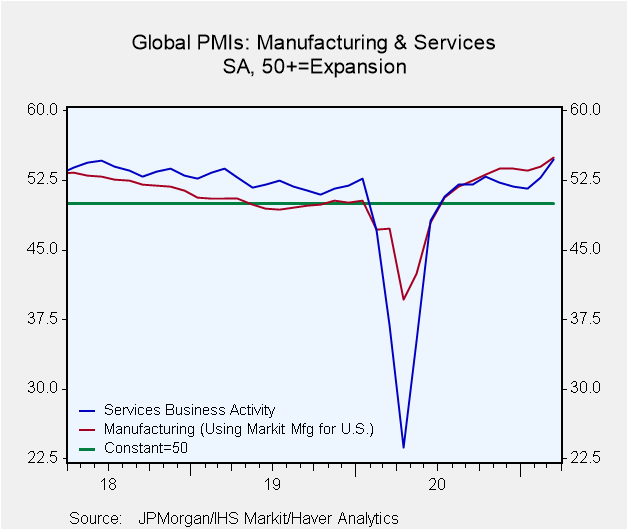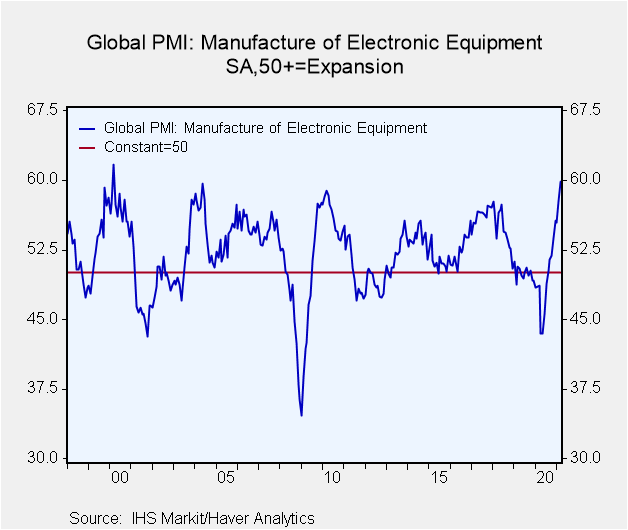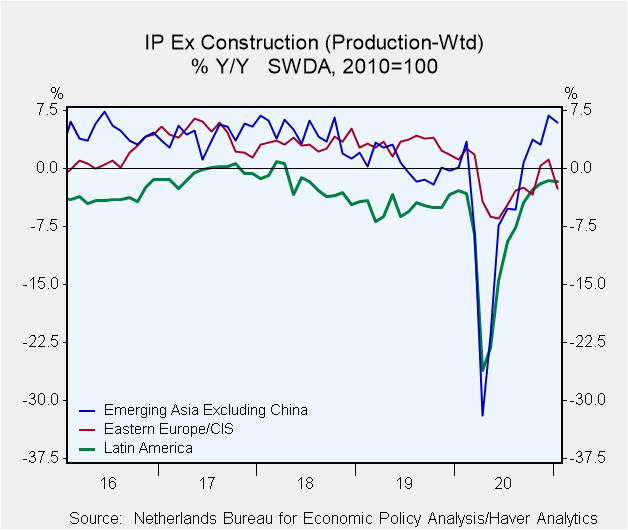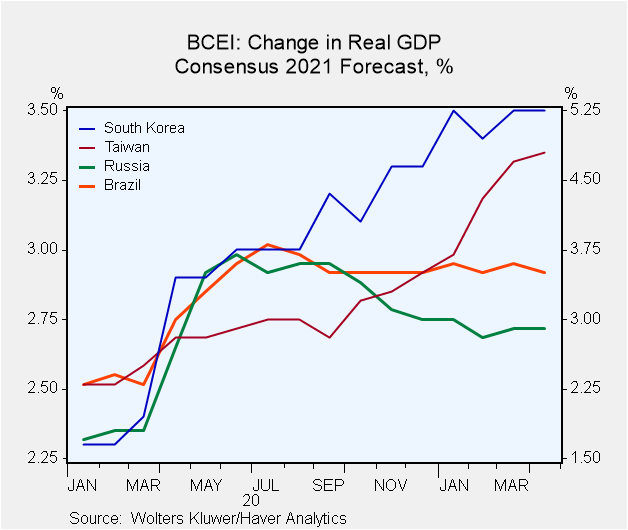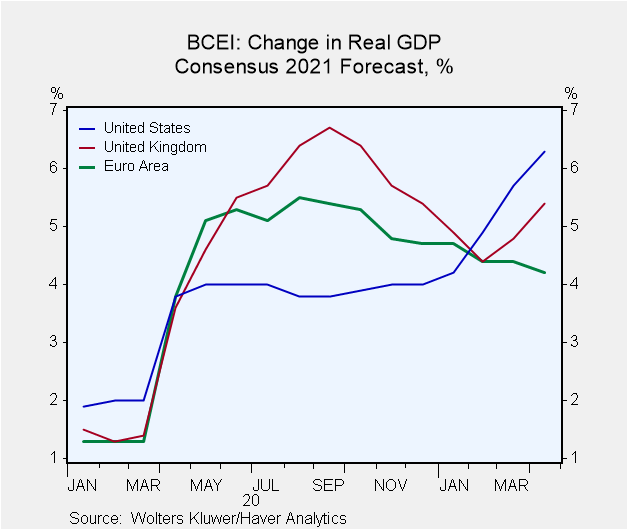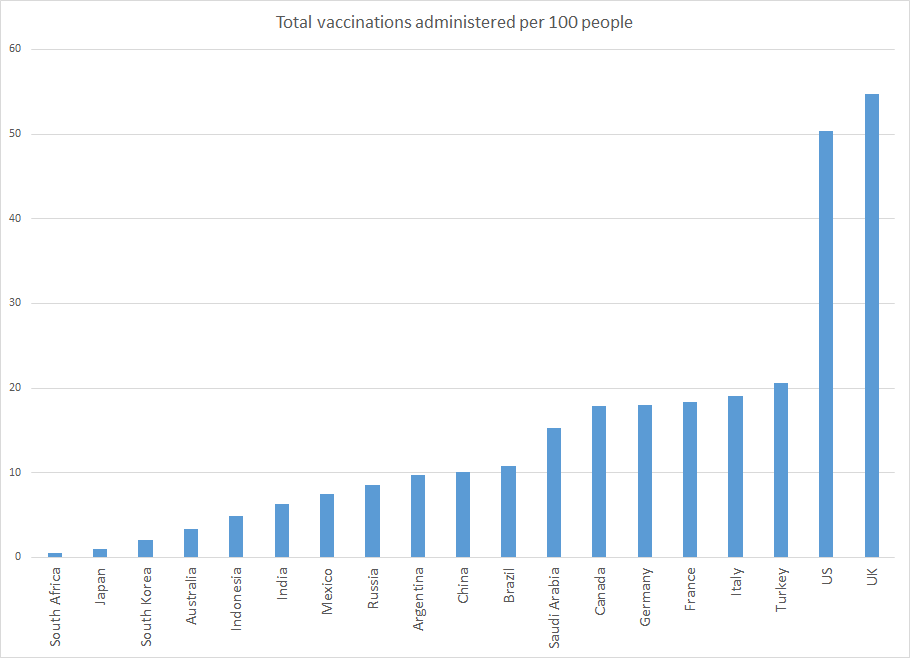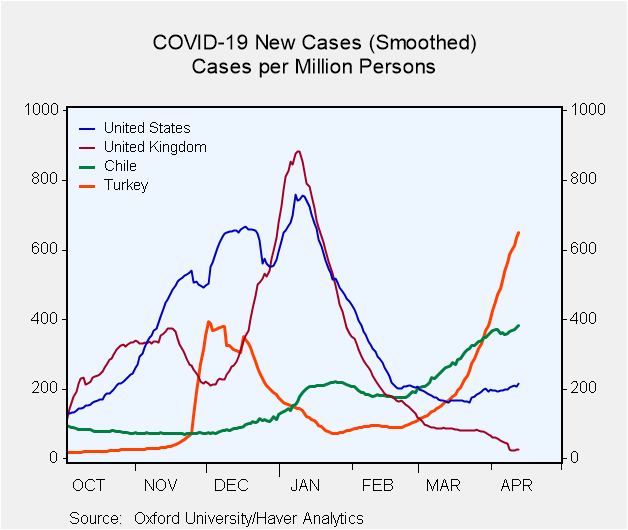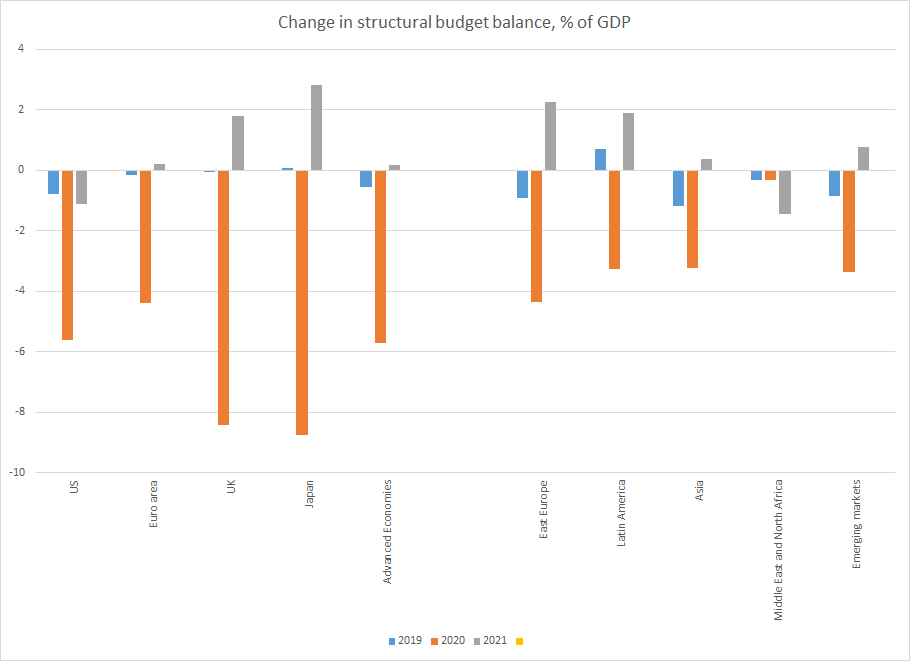 Global| Apr 14 2021
Global| Apr 14 2021A Rising Tide Isn't Yet Lifting All Boats
by:Andrew Cates
|in:Viewpoints
Summary
The aphorism "a rising tide lifts all boats" – commonly attributed to John F Kennedy - is often associated with the idea that an improving economy will benefit all participants. Policymakers ought to accordingly maintain a broad focus [...]
The aphorism "a rising tide lifts all boats" – commonly attributed to John F Kennedy - is often associated with the idea that an improving economy will benefit all participants. Policymakers ought to accordingly maintain a broad focus in their endeavours and not concern themselves too much with the way a spurt of economic growth has been distributed.
This comes to mind at present in reviewing latest economic developments. For while recent trends in many global macroeconomic aggregates have been positive, a deeper diver into the regional, country or sector-specific details suggest less cause for celebration. The global recovery, in short, appears to be highly uneven. Many, although not necessarily all, of the reasons for this are rooted in how various countries are responding to COVID. Some, though, are also a legacy of factors that pre-date the pandemic but which also have global roots. Economic stability in the period ahead will arguably now hinge on the degree to which policymakers are attuned to these global considerations and how financial markets respond.
Upbeat global economic data
Let's begin this commentary, though, with the good news. Much of the forward-looking data in the past two weeks have been painting a rosy picture of the global economic outlook. For example, purchasing managers surveys from a number of major countries have exhibited greater vigour. That applies in particular to the manufacturing sector but increasingly now to the services sector as well (see figure 1). The latter had hitherto been more restrained compared with manufacturing owing to the impact of lockdown restrictions in areas such as retail, hospitality and travel.
Figure 1: Positive global PMI readings in both manufacturing and services
This all chimes with many other data points including this week's trade data for March from China. The underlying sectoral details of PMIs – as well as China's trade data – moreover also continue to speak positively about global demand for information and communications technology products. Indeed, the Global PMI for the manufacture of electronic equipment rose to a twenty year high in March (see figure 2 below).
Figure 2: Global PMI of Electronic Equipment
Uneven growth rates in emerging regions
But while this trend is undeniably upbeat for high-tech manufacturers in Asia this is masking more uneven recovery progress in other major emerging regions. Industrial production declined in Latin American and Eastern Europe in January from a year earlier, for example, extending fairly wretched trends that have established themselves in recent years (see figure 3). A ‘de-globalisation' of the world economy and its impact on export growth in a number of EM countries has taken a heavy toll. The COVID pandemic – and the further restraint on world trade that this has yielded – have played a bigger role in recent months.
Figure 3: Divergent industrial production growth in emerging regions
A diverging consensus
This regional and sectoral imbalance though is also generating understandable shifts in forecasters' sentiment. Asian economies that have a high exposure to information and communications technology trade – such as Taiwan and South Korea – have seen relatively large upward revisions to their GDP forecasts for 2021 over the past few months. In contrast, those economies that have relatively high exposure to ‘older economy' sectors, such as Russia and Brazil, have seen more stability or more downside in their growth revisions (see figure 4 below).
Figure 4: Positive revisions to South Korea and Taiwan consensus, less upside in Russia and Brazil
However, this divergence in forecaster sentiment doesn't only apply to emerging economies. Sharp upward revisions to the Blue Chip GDP consensus for 2021 greeted the US and the UK in April (see figure 5). This though contrasted with a downward revision to the 2021 consensus for the Euro area.
Figure 5: Positive revisions to US and UK GDP forecasts for 2021, downward revisions to Euro area
COVID considerations
The underlying reasons for those developed economy shifts in consensus GDP arithmetic are partly rooted in COVID considerations. A comparison of vaccination rates in the G20 nations reveals that the US and UK are some way ahead now of progress in many other major economies (see figure 6 below). This is understandably generating varying response rates from consumer and business confidence. More importantly, it is allowing US and UK policymakers to ease lockdown restrictions and accordingly to free up slices of economic activity.
Figure 6: Vaccination rates in the G20
Source: University of Oxford/Haver Analytics
Two further trends though are also of note on this score. Firstly, that the US and UK have continued to see falling hospitalisation rates in recent weeks which stands in vivid contrast to other countries whose vaccination rates are much lower and which have seen higher hospitalisation numbers (see figure 7 below).
Figure 7: Hospital patient numbers in the US and UK continue to fall
Source: University of Oxford/Haver Analytics
The second trend relates to falling case numbers in recent weeks in countries that have vaccinated heavily (e.g. the UK), a now-modest increase in the case number trend in the US, and much higher case numbers in countries such as Turkey and Chile, which have also vaccinated a reasonably large chunk of their population (though a lower chunk compared with the US and UK).
Figure 8: Rising cases in Turkey and Chile (and the US), falling cases in the UK
The bottom line from this COVID discussion is that vaccination rollouts are uneven. Vaccination success though is also a little uneven. It appears to be yielding great success in hospitalisation numbers but it does not yet appear to be yielding the same payoff in falling case numbers. Other factors in other words still matter here including lockdown stringency and possibly COVID mutations.
Policy and balance sheets
The final couple of factors that are surely contributing to the global recovery's uneven progress relate firstly to policy and secondly to balance sheets. As the IMF has noted of late in its April global economic, financial and policy updates, the looser stance of both monetary and fiscal policy have been key drivers of global economic improvement in recent weeks. Yet as also noted, the lack of fiscal policy space in many emerging countries has generated much less accommodation in that bloc relative to most advanced economies (see figure 9). And that lack of space can, in part, be traced to the weakness of sovereign balance sheets that's been triggered by the era of de-globalisation in recent years. As the IMF further noted, emerging market policymakers could therefore face much tougher times ahead, with additionally more constrained monetary policy space off the back of rising inflation. That is of course unless positive spill-overs from a rising global economic tide begins to lift its boats.
Figure 9: Easier fiscal policy in advanced economies relative to emerging economies
Source: IMF/Haver Analytics
Viewpoint commentaries are the opinions of the author and do not reflect the views of Haver Analytics.Andrew Cates
AuthorMore in Author Profile »Andy Cates joined Haver Analytics as a Senior Economist in 2020. Andy has more than 25 years of experience forecasting the global economic outlook and in assessing the implications for policy settings and financial markets. He has held various senior positions in London in a number of Investment Banks including as Head of Developed Markets Economics at Nomura and as Chief Eurozone Economist at RBS. These followed a spell of 21 years as Senior International Economist at UBS, 5 of which were spent in Singapore. Prior to his time in financial services Andy was a UK economist at HM Treasury in London holding positions in the domestic forecasting and macroeconomic modelling units. He has a BA in Economics from the University of York and an MSc in Economics and Econometrics from the University of Southampton.


